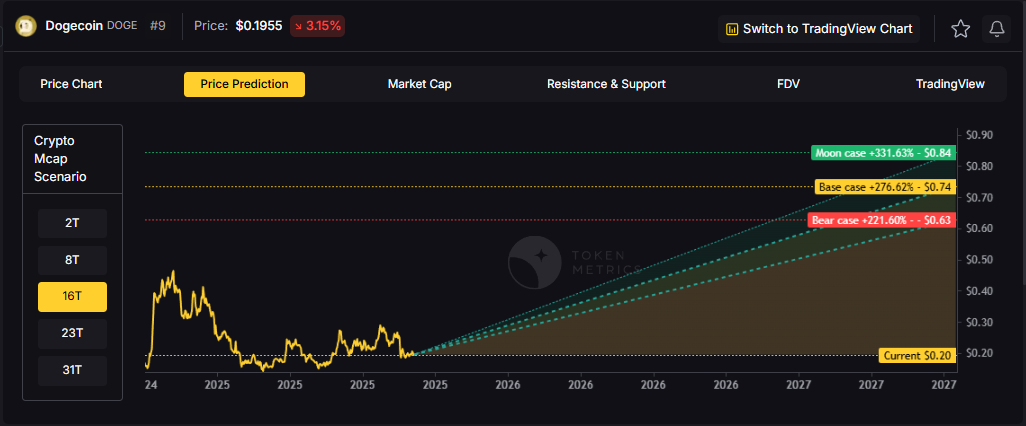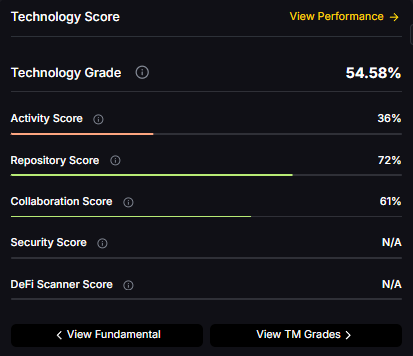
Measuring Success: The Complete Guide to Evaluating Token Metrics AI Indices Performance

Ask most cryptocurrency investors how their portfolio is performing, and they'll immediately cite a percentage return: "I'm up 50%" or "I'm down 30%." While simple returns matter, this single-dimensional view of performance obscures critical information about risk, consistency, and sustainability. Two portfolios with identical 50% returns might differ dramatically in risk profile—one achieving gains through steady appreciation, the other through wild volatility that could reverse suddenly.
Professional investors and institutional fund managers evaluate performance through multiple sophisticated metrics that reveal not just how much return was achieved, but how efficiently risk was managed, how consistently profits were generated, and how the strategy performed relative to relevant benchmarks. These metrics separate lucky speculation from skillful investing, and short-term anomalies from sustainable long-term strategies.
Token Metrics AI Indices are designed to deliver not just strong absolute returns, but superior risk-adjusted performance across multiple evaluation dimensions. Understanding these performance metrics empowers you to make informed decisions about index selection, allocation sizing, and strategy adjustments. This comprehensive guide reveals the key metrics that matter, how to interpret them correctly, and how to use data-driven evaluation to optimize your Token Metrics investment approach.
The Fundamental Performance Metrics
Absolute Returns: The Starting Point
Absolute return measures simple percentage gain or loss over a specific period. If you invest $10,000 and it grows to $15,000, your absolute return is 50%. This basic metric provides important information but tells an incomplete story.
When evaluating Token Metrics indices, examine absolute returns across multiple timeframes including month-to-date and quarter-to-date for recent performance, year-to-date capturing current year results, one-year, three-year, and five-year returns for medium-term perspective, and since-inception returns showing complete track record.
Different timeframes reveal different aspects of performance. Short-term returns show current momentum and responsiveness to market conditions. Long-term returns demonstrate consistency and compound effectiveness. Always evaluate multiple timeframes rather than fixating on any single period.
Annualized Returns: Comparing Across Timeframes
Annualized return converts returns of any length into equivalent annual percentage, enabling fair comparisons. A 100% return over two years annualizes to approximately 41% annually—useful for comparing against one-year returns of other investments.
Token Metrics reports annualized returns for all indices, facilitating comparisons across different indices with different inception dates and holding periods. When evaluating indices, prioritize annualized returns over cumulative returns for more meaningful comparisons.
Compound Annual Growth Rate (CAGR): The Smoothed View
CAGR shows the geometric mean annual return smoothing out volatility to reveal underlying growth trajectory. If a portfolio grows from $10,000 to $20,000 over three years, the CAGR is 26%, even if year-one returned 50%, year-two lost 10%, and year-three gained 40%.
CAGR proves particularly valuable for crypto investing given extreme year-to-year volatility. It reveals the "smoothed" growth rate you've achieved, providing perspective beyond dramatic individual periods.
Risk-Adjusted Performance: The Professional Standard
Why Risk-Adjusted Returns Matter More Than Absolute Returns
Achieving 100% returns sounds impressive, but if that required accepting 80% maximum drawdown risk, was it worth it? Another portfolio delivering 60% returns with only 20% maximum drawdown might actually be superior despite lower absolute returns.
Risk-adjusted metrics evaluate returns relative to risk taken. Professional investors prioritize risk-adjusted performance over absolute returns because higher risk-adjusted returns indicate skillful investing rather than lucky risk-taking. Two critical principles: more return for given risk is better, and less risk for given return is better.
Sharpe Ratio: The Gold Standard
The Sharpe Ratio, developed by Nobel laureate William Sharpe, measures risk-adjusted returns by dividing excess returns (returns above risk-free rate) by standard deviation (volatility). Higher Sharpe Ratios indicate better risk-adjusted performance.
Sharpe Ratio = (Portfolio Return - Risk-Free Rate) / Portfolio Standard Deviation
A Sharpe Ratio above 1.0 is considered good, above 2.0 is very good, and above 3.0 is exceptional. Traditional equity portfolios typically achieve Sharpe Ratios of 0.5-1.0. Token Metrics indices targeting 1.5+ Sharpe Ratios demonstrate superior risk-adjusted performance.
When comparing indices, prioritize higher Sharpe Ratios over higher absolute returns. An index with 40% returns and 1.8 Sharpe Ratio likely provides better risk-adjusted value than an index with 60% returns and 1.2 Sharpe Ratio.
Sortino Ratio: Focusing on Downside Risk
The Sortino Ratio improves on Sharpe Ratio by considering only downside volatility (negative returns) rather than total volatility. This distinction matters because upside volatility (large gains) isn't truly "risk"—investors welcome positive surprises.
Sortino Ratio = (Portfolio Return - Risk-Free Rate) / Downside Deviation
Higher Sortino Ratios indicate portfolios that deliver returns efficiently while minimizing painful drawdowns. Token Metrics' focus on downside protection through diversification and risk management typically produces strong Sortino Ratios.
Calmar Ratio: Return Per Unit of Maximum Drawdown
The Calmar Ratio divides annualized return by maximum drawdown, measuring how much return you earn per unit of worst-case loss.
Calmar Ratio = Annualized Return / Maximum Drawdown
If an index delivers 50% annualized returns with 25% maximum drawdown, its Calmar Ratio is 2.0. Higher ratios indicate more efficient return generation relative to worst-case scenarios. Token Metrics indices emphasizing drawdown management typically show strong Calmar Ratios.
Volatility Metrics: Understanding the Ride
Standard Deviation: Measuring Total Volatility
Standard deviation quantifies how much returns fluctuate around their average. Higher standard deviation means more volatility—both upside and downside.
Cryptocurrency exhibits extreme volatility. Bitcoin's annualized volatility often exceeds 60-80%, compared to 15-20% for stock markets. Token Metrics indices typically show lower volatility than Bitcoin through diversification, though still higher than traditional assets.
When evaluating indices, consider your volatility tolerance. If 50% annual volatility causes anxiety impairing sleep or decision-making, choose lower-volatility indices even if that sacrifices some return potential.
Beta: Relative Volatility to Benchmarks
Beta measures how much a portfolio moves relative to a benchmark (typically Bitcoin for crypto indices). Beta of 1.0 means the portfolio moves identically with the benchmark. Beta above 1.0 indicates amplified movements (higher volatility), while beta below 1.0 indicates dampened movements (lower volatility).
Token Metrics large-cap indices typically show betas near 0.8-1.0 relative to Bitcoin—moving somewhat similarly but with slightly reduced volatility through diversification. Growth indices might show betas of 1.2-1.5, amplifying Bitcoin's movements for enhanced return potential at higher risk.
Understanding beta helps set appropriate expectations. If Bitcoin returns 30% and your index has beta of 1.2, expect approximately 36% returns. If Bitcoin declines 20%, expect approximately 24% decline.
Maximum Drawdown: Worst-Case Scenario
Maximum drawdown measures the largest peak-to-trough decline during any period. If a portfolio grows from $10,000 to $20,000, then drops to $12,000, the maximum drawdown is 40% (from $20,000 peak to $12,000 trough).
Maximum drawdown reveals worst-case scenarios—critical information for risk management. Can you psychologically and financially tolerate a 50% maximum drawdown? If not, avoid strategies historically experiencing such declines.
Token Metrics indices show varying maximum drawdowns based on strategy. Conservative large-cap indices might experience 40-50% maximum drawdowns during severe bear markets, while aggressive growth indices might see 60-70% drawdowns. Understanding these historical ranges helps set realistic expectations.
Downside Capture and Upside Capture Ratios
Downside capture measures how much of benchmark's negative returns a portfolio captures. 80% downside capture means when the benchmark declines 10%, the portfolio declines 8%—better downside protection.
Upside capture measures participation in benchmark gains. 120% upside capture means when the benchmark rises 10%, the portfolio rises 12%—enhanced upside participation.
Ideal portfolios combine high upside capture with low downside capture. Token Metrics indices achieving 110% upside capture and 85% downside capture demonstrate skill in capturing gains while protecting during declines.
Get Started For Free
Benchmark Comparisons: Relative Performance
Choosing Appropriate Benchmarks
Performance must be evaluated relative to relevant benchmarks. For crypto indices, appropriate benchmarks include Bitcoin (the dominant cryptocurrency), Ethereum (leading smart contract platform), total crypto market cap indices, and equal-weighted crypto indices.
Token Metrics provides benchmark comparisons for all indices, typically against Bitcoin and total market indices. Evaluate whether indices outperform or underperform these benchmarks after adjusting for risk.
Alpha Generation: Beating the Benchmark
Alpha measures returns exceeding benchmark returns after adjusting for risk. Positive alpha indicates skillful investing beating passive benchmark holding. An index delivering 40% returns when Bitcoin returned 30%, with similar risk profiles, generates positive alpha.
Token Metrics' AI-driven approach aims to generate consistent positive alpha through superior token selection, optimal diversification, and systematic rebalancing. Historical alpha generation provides evidence of whether indices add value beyond passive Bitcoin holding.
Tracking Error: Consistency of Outperformance
Tracking error measures how consistently a portfolio's returns differ from benchmarks. Low tracking error means returns closely match benchmarks, while high tracking error indicates returns diverge significantly—either positively or negatively.
For active strategies like Token Metrics indices, some tracking error is expected and desirable—that's how alpha is generated. But excessive tracking error indicates unpredictable performance making planning difficult.
Time-Period Analysis: Understanding Performance Consistency
Rolling Returns: Capturing All Periods
Rolling returns analyze performance across all possible time periods rather than just fixed calendar periods. For example, examining all possible one-year periods in a five-year track record (starting every day) rather than just comparing 2020 vs. 2021 vs. 2022.
Rolling returns reveal consistency. An index showing positive rolling one-year returns 80% of the time demonstrates more consistency than one positive only 50% of the time, even with similar average returns.
Token Metrics reports rolling returns for various periods, helping evaluate consistency across market conditions. Prefer indices with strong rolling return performance over those with dramatic but inconsistent results.
Performance in Different Market Conditions
Evaluate how indices perform across different market regimes including bull markets (strong uptrends), bear markets (sustained declines), sideways markets (range-bound conditions), and high volatility vs. low volatility periods.
Indices performing well in all conditions demonstrate robustness. Those performing well only in specific conditions require tactical timing for success. Token Metrics' adaptive AI aims for "all-weather" performance, though some indices intentionally specialize in particular conditions (momentum indices excel in trends, for example).
Drawdown Recovery: Bouncing Back
Beyond maximum drawdown magnitude, examine recovery time—how long portfolios take recovering to previous peaks after drawdowns. Faster recovery indicates resilience.
If two indices both experience 50% maximum drawdowns, but one recovers in 6 months while the other takes 2 years, the first demonstrates superior resilience. Token Metrics' systematic rebalancing and diversification typically support faster drawdown recovery than concentrated portfolios.
Practical Application: Using Metrics to Make Better Decisions
Selecting Indices Based on Your Profile
Use performance metrics to match indices with your investment profile. Conservative investors prioritize lower maximum drawdown, higher Sharpe/Sortino ratios, lower standard deviation, and consistent rolling returns even with moderate absolute returns.
Aggressive investors accept higher maximum drawdown, might tolerate lower Sharpe ratios for higher absolute returns, embrace higher volatility, and can handle inconsistent periods if upside is substantial.
Review Token Metrics' index performance data with these priorities in mind, selecting indices aligning with your risk-return preferences.
Monitoring Performance Over Time
After investing, monitor performance quarterly using key metrics including absolute and risk-adjusted returns relative to benchmarks, maximum drawdown tracking whether risk parameters are respected, consistency metrics like rolling returns, and comparison against initial expectations.
If an index consistently underperforms benchmarks on risk-adjusted basis for 12+ months, consider switching to alternatives better meeting objectives. But avoid reactive switching based on short-term underperformance—all strategies experience periods of weakness.
Setting Realistic Expectations
Performance metrics help set realistic expectations. If historical maximum drawdowns reached 60%, expect similar or worse in the future. If annual returns averaged 40% with 30% standard deviation, don't expect consistent 40% returns every year—expect dramatic variation around that average.
Token Metrics provides comprehensive historical data supporting realistic expectation-setting. Use this data to mentally prepare for inevitable volatility and drawdowns, preventing emotional reactions when they occur.
Red Flags and Warning Signs
Certain performance patterns raise concerns including consistently increasing maximum drawdowns each cycle, declining Sharpe Ratios over time, persistent underperformance vs. benchmarks, increasing volatility without corresponding return increase, and inconsistent methodology or strategy drift.
Monitor for these red flags. While Token Metrics maintains rigorous quality standards, all strategies face challenges. Being attentive to warning signs enables proactive adjustments before problems become severe.
Advanced Metrics for Sophisticated Investors
Information Ratio: Consistency of Alpha
The Information Ratio measures how consistently a portfolio generates alpha relative to tracking error—essentially measuring manager skill.
Information Ratio = Alpha / Tracking Error
Higher Information Ratios indicate skillful, consistent outperformance rather than lucky or erratic results. Token Metrics targeting Information Ratios above 0.5 demonstrates systematic alpha generation.
Omega Ratio: Complete Risk-Return Profile
The Omega Ratio evaluates the entire distribution of returns, capturing all moments (mean, variance, skewness, kurtosis) rather than just first two moments like Sharpe Ratio.
Higher Omega Ratios indicate superior risk-return profiles capturing nuances missed by simpler metrics. While complex to calculate, Token Metrics provides Omega Ratios for indices, offering sophisticated performance evaluation.
Tail Risk Metrics: Extreme Event Analysis
Tail risk metrics evaluate performance during extreme market conditions including Value at Risk (VaR), Conditional Value at Risk (CVaR), and skewness/kurtosis.
These metrics reveal how indices perform during "black swan" events—rare but catastrophic market crashes. Token Metrics' diversification and risk management aim to reduce tail risk compared to concentrated crypto positions.
Creating Your Performance Dashboard
Essential Metrics to Track
Build a performance dashboard tracking key metrics for your Token Metrics holdings including monthly absolute and benchmark-relative returns, year-to-date and inception-to-date returns, Sharpe and Sortino Ratios, current drawdown from peak, maximum drawdown history, and rolling one-year returns.
Review this dashboard quarterly, taking notes on performance patterns, concerns, and successes. This systematic tracking prevents both complacency during good times and overreaction during difficult periods.
Using Token Metrics Platform Analytics
Token Metrics platform provides comprehensive performance analytics eliminating manual calculation needs. Familiarize yourself with available reports, charts, and comparison tools. Use these resources to monitor your holdings and evaluate alternative indices.
Set up automated performance reports if available, receiving regular updates without requiring active checking. This ensures you stay informed while avoiding obsessive daily monitoring that encourages emotional reactions.
Sharing Performance Discussions
Consider engaging with Token Metrics community forums or discussion groups sharing performance observations and questions. Other investors' perspectives provide valuable context and help identify whether your experience is typical or exceptional.
While past performance never guarantees future results, collective intelligence from many users evaluating indices from different perspectives enriches understanding and improves decision-making.
Token Metrics: Driving Data-Driven Index Evaluation
Token Metrics offers users institutional-grade analytics and a wealth of index performance data in one convenient platform. Whether you are reviewing absolute returns, risk-adjusted metrics, or comparing indices to top crypto benchmarks, Token Metrics provides easy-to-understand charts, rolling performance snapshots, and advanced tools for anyone seeking thorough, data-informed analysis. These resources empower crypto investors to track, compare, and refine their portfolios using transparent, actionable performance insights.
FAQ
What is the most important metric for evaluating a crypto index?
No single metric is most important—well-rounded evaluation considers absolute returns, risk-adjusted performance (like Sharpe and Sortino ratios), maximum drawdown, and consistency versus benchmarks.
How often should investors review index performance data?
Quarterly reviews using comprehensive dashboards (tracking returns, drawdowns, risk ratios, and benchmark comparisons) help investors set realistic expectations and guide data-driven adjustments.
Why is volatility especially relevant for crypto indices?
Cryptocurrency is known for high volatility, which can affect investor psychology. Understanding historical volatility helps investors select indices that match risk tolerance and minimize unexpected stress.
How do Sharpe and Sortino ratios differ?
Both measure risk-adjusted returns, but Sharpe considers total volatility while Sortino considers only downside risk. High Sortino ratios indicate efficient downside protection.
Why compare crypto indices to benchmarks?
Benchmarks like Bitcoin or total crypto market indices provide a reference point. Comparing performance reveals if an index adds value through alpha or if it simply follows wider market trends.
Disclaimer
This article is for informational and educational purposes only and does not constitute financial advice, investment recommendations, or an offer to buy or sell any security or asset. Performance metrics and statistics discussed reflect historical data and should not be interpreted as guarantees of future outcomes. Past performance is not indicative of future results. Investors should conduct their own research and consult with qualified professionals before making investment decisions.
Get Started For Free

.svg)

Create Your Free Token Metrics Account

.png)




%201.svg)
%201.svg)


%201.svg)
















.svg)




.png)